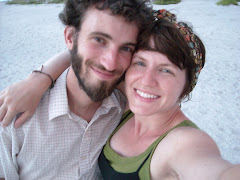Livrezon is finished! We distributed thousands of trees from 22 community nurseries in 7 work days. Phew. This morning I relaxed and slept in until 6:30am.
It was pretty interesting, actually, to have the chance to go on a condensed "tour" of the nurseries and see the committees (and communities) in action. Some committees ran the distribution like old pros, asking people to line up and calmly wait for each kind of tree. In other communities the receivers were less gracious, pressing impatiently against one another as they waited their turns - and even turning up their noses at certain species.
While on the one hand watching seedlings go out into the big wide world in the hands of people who will care for them is heartwarming, and makes the last year's work all seem worth it, there is something about the tree distributions that made both Bryan and me uncomfortable. We knew that some trees were sold and some were given away - but for some reason we thought that
most of the trees were sold; in reality, the nurseries give away 90% of the trees and reserve only a few to sell. We thought that if someone pays for something, even just a nominal fee, that person is more likely to value and care for that thing, right?
As usual in Haiti, it's complicated. Since MCC has been giving away trees for most of its 25-year history, it's hard to change this strategy quickly (a former MCCer in Dezam pointed out that MCC nurseries only started selling trees within the last 5 years). The community members expect a certain number of trees, and in a way, not giving them trees is a vote of unconfidence, a gesture that would be perceived as a lack of faith in their ability to plant and care for trees. Also, if our primary goal is reforestation and not community development, it makes sense to take advantage of the thousands of volunteers willing to plant and care for trees on their own land.
Community development, however, is an overarching goal of the program. Even in the short time we've been here, I've noticed how people take pride in their work with MCC. Our teachers and nursery committee members are learning about community organizing, running small businesses, and getting students involved. As foreigners in Haiti, a country where many people have developed a mentality of dependency on foreign aid (with the accompanying expectations and attitudes of entitlement), MCC's emphasis on empowering Haitians to run this program has been its most heartening aspect. From this perspective, grand-scale distributions make us feel like just another couple of white people here to hand something out.
Last week, a few people frustrated with the number of trees they were getting (only about 25 each) told Bryan, "If MCC won't give us trees, we'll just grow our own!"
So, um. Wouldn't this be the best possible outcome, that the people living in these communities would start to improve the land on their own?
Maybe we should start to rethink the way MCC's program approaches the issue of deforestation, encouraging communities to think of our nurseries as a resource for their own endeavors.
-posted by Sharon, from Bryan's account
 I also think this kid in his sneakers is
I also think this kid in his sneakers is Most cases hold 96 trees, and we carried up about 65 of them.
Most cases hold 96 trees, and we carried up about 65 of them. He lives near where we parked the trucks, tagged along, and
He lives near where we parked the trucks, tagged along, and This was him taking a break.
This was him taking a break.











